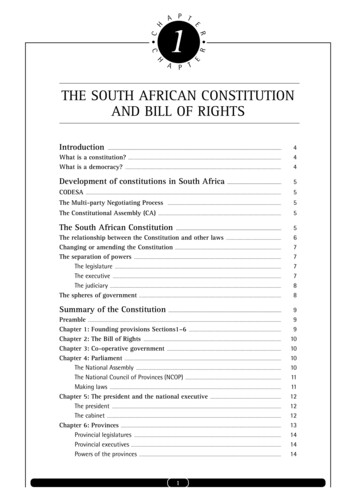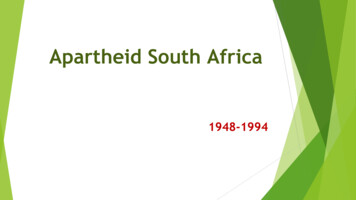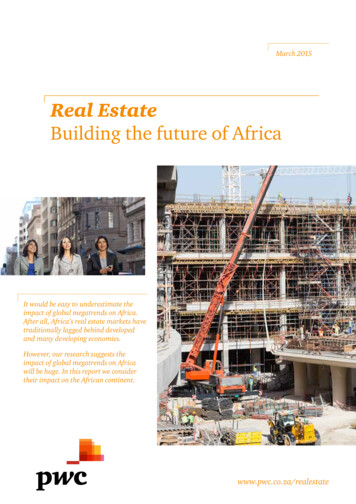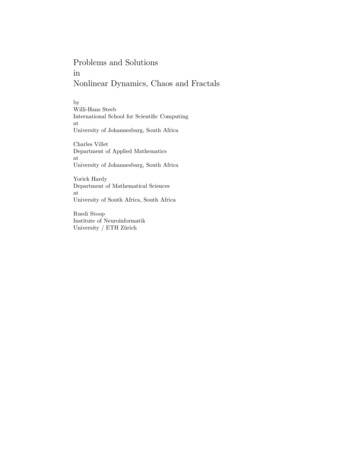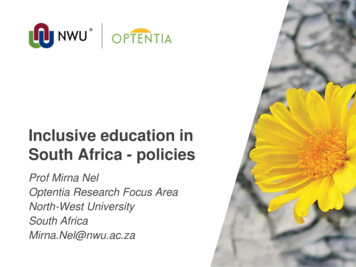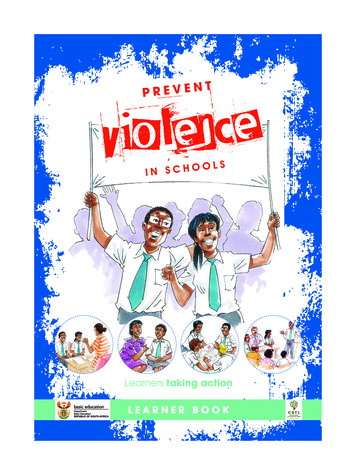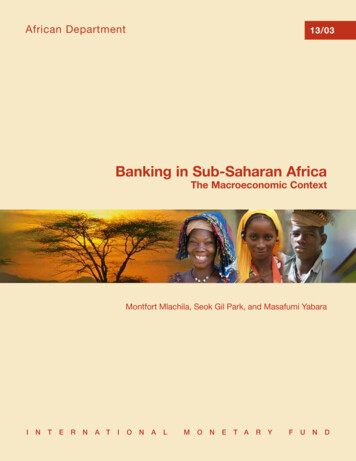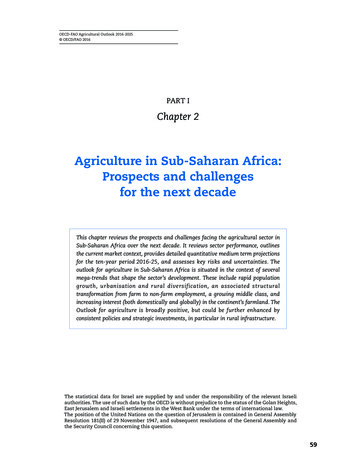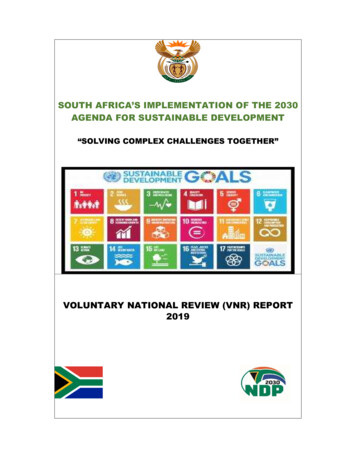
Transcription
SOUTH AFRICA’S IMPLEMENTATION OF THE 2030AGENDA FOR SUSTAINABLE DEVELOPMENT“SOLVING COMPLEX CHALLENGES TOGETHER”VOLUNTARY NATIONAL REVIEW (VNR) REPORT2019
ABREVIATIONS AND DOJDoWDPMEDRRDSDDSTDTADTIDVADWAFDWSECDEEATen Year Framework ProgrammeThird Generation NetworkFourth Industrial RevolutionFifth Generation NetworkAddis Ababa Action AgendaAfrican Development BankAfrica Investment ProgrammeAcid Mine DrainageAfrican Peer Review MechanismAccelerated and Shared Growth Initiative for South AfricaAfrican UnionBroad Based Black Economic EmpowermentBusiness Expenditure on Research and DevelopmentBus Rapid TransitCommunity Atmosphere Biosphere Land ExchangeCommunity Advice OfficesCentre for the Advancement of Community Advice Offices of SouthAfricaComprehensive Agricultural Support ProgrammeCommission for Gender EqualityCentre of Excellence for Integrated Mineral and Energy ResourceAnalysisCompressed Natural GasCarbon DioxideCenter of ExcellenceCentre of GovernmentDepartment of Cooperative Governance and Traditional AffairsComprehensive Rural Development ProgrammeCouncil for Scientific and Industrial ResearchCivil Society OrganisationsDepartment of Agriculture, Forestry and FisheriesDepartment of Basic EducationDesign, Build, Operate and MaintainDepartment of Correctional ServicesDepartment of Environmental AffairsDevelopment Finance InstitutionsDepartment of Higher Education and TrainingDepartment of International Relations and CooperationDepartment of EducationDepartment of HealthDepartment of JusticeDepartment of WomenDepartment of Planning, Monitoring and EvaluationDisaster Risk ReductionDepartment of Social DevelopmentDepartment of Science and TechnologyDepartment of Traditional AffairsDepartment of Trade and IndustryDomestic Violence ActDepartment of Water Affairs and ForestryDepartment of Water and SanitationEarly Childhood DevelopmentEmployment Equity Act1
MIGMOIMRCEnglish as a First Additional LanguageEarly Grade Reading StudyExpanded Public Works ProgrammeEconomic Sectors, Employment and Infrastructure DevelopmentEuropean UnionFree Basic Alternative EnergyFree Basic ElectricityFinancing for Development (3rd International Conference)Female Genital MutilationForest Molecular Genetics ProgrammeFull-Time EquivalentGovernance and AdministrationGroup of 77 (coalition of 134 developing nations)Group B StreptococcusGovernment Communication and Information SystemGlobal Compact Network South AfricaGross Domestic ProductGrowth, Employment and RedistributionGross Expenditure on Research and Development (as a percentageof GDP)Gauteng Freeway Improvement ProgrammeGlobal Programme for Infectious Diseases – ResearchNew Growth PathGigawattGigawatt HoursHydrogen Fuel Cell TechnologyHuman Immunodeficiency VirusHigh Level Political ForumHigh Level Panel on WaterHuman Sciences Research CouncilHydrogen South AfricaInformation and Communication TechnologyInternational Cooperation, Trade and SecurityIntegrated Development PlansIndustrial Development ZonesNational Integrated Energy PlanIndigenous Microbial Diversity (based technologies)Integrated National Electrification ProgrammeIndependent Power ProducersInternational Renewable Energy AgencyIntegrated Resource PlanIntegrated School Health PolicyJustice, Crime Prevention and SecurityKey Biodiversity AreasLower-Bound Poverty Line (R785 in April 2018 prices and R647 inApril 2015 per person per month)Life Cycle AssessmentsLand Consumption Rate to Population Growth RateLiving Conditions SurveyLocal Economic DevelopmentLabour Relations ActLong Term EvolutionMicro Agricultural Financial Institution of South AfricaMainstreaming, Acceleration and Policy SupportMillennium Development GoalsMunicipal Infrastructure GrantMeans of ImplementationMedical Research Council2
NSAIABSAMPISANEDISANSASAPsSARChIMaster of Science DegreeMedium Term Strategic FrameworkMegawattNon-Communicable DiseasesNationally Determined ContributionNational Development PlanNational Economic Development and Labour CouncilNational Energy Efficiency StrategyNational Framework for Sustainable DevelopmentNon-Governmental OrganisationsNational Health InsuranceNational Income Dynamics StudyNational Planning CommissionNational Research and Development StrategyNational Register for Sex OffendersNational Research FoundationNational Science FoundationNational System of InnovationNational Strategy for Sustainable Development and Action PlanNational Urban Reconstruction and Housing AgencyNational Water and Sanitation Master PlanNational Water ActNational Waste Management StrategyNational Water PolicyNational Water Resources StrategyOfficial Development AssistanceOccupational Specific DispensationPromotion of Access to Information Act of 2000Post-Exposure ProphylaxisPromotion of Equality and Prevention of Unfair Discrimination ActProvincial Growth and Development StrategyPhilosophy of Primary HealthcareDoctoral DegreeProgress in International Reading Literacy StudyProgramme of ActionPost School Education and TrainingPhotovoltaicPricewaterhouse CoopersQuarterly Employment StatisticsResearch and DevelopmentRecapitalisation and Development ProgrammeRegional Bulk Infrastructure GrantReference Daily IntakeReconstruction and Development ProgrammeRenewable Energy Independent Power Producers ProgrammeRural Housing Loan FundRural Innovation Assessment ToolRegional Indicative Strategic Development ProgrammeSouth AfricaSouth African Council for EducatorsSouthern African Development CommunitySouth African Environmental Observation NetworkSouth African Institute for Aquatic BiodiversitySouth African Multidimensional Poverty IndexSouth African National Energy Development InstituteSouth African National Space AgencySouth African Police ServiceSouth African Research Chairs Initiative3
ATSOEsSoNASPCHDStats YESSouth African Schools ActSustainable Consumption and ProductionSustainable Development GoalsSouthern and Eastern Africa Consortium for Monitoring EducationalQualityStrategic Framework on Water ServicesStrategic Health Innovation ProgrammeSolar Home SystemsSmall and Medium EnterpriseSmall, Medium and Micro EnterprisesSchool Nutrition ProgrammeSexual Offenses and Related Matters ActSexual Offences CourtsSurface Ocean CO2 AtlasState Owned EnterprisesState of the Nation AddressesSocial Protection, Community and Human DevelopmentStatistics South AfricaSingle Transport Economic RegulatorScience, Technology and InnovationSexually Transmitted InfectionsTuberculosisTechnology Facilitation MechanismTrends in International Mathematics and Science StudyUpper-Bound Poverty Line (R1 183 in April 2018 prices and R992 inApril 2015 per person per month)United KingdomUnited Nations Convention to Combat DesertificationUnited Nations Development ProgrammeUnited Nations Environment ProgrammeUnited Nations Framework Convention on ClimateUnited Nations Security CouncilUnited States Agency for International DevelopmentValue Added TaxVictim Empowerment ProgrammeVictim Friendly RoomsVery High FrequencyVoluntary National ReviewVariable-resolution Earth System ModelWorld Intellectual Property OrganisationWater Services ActWater Source AreasWater Services Development PlansWater Services Infrastructure GrantWorld Trade OrganisationYouth Environmental Services4
Contents ABREVIATIONS AND ACRONYMS1 OPENING STATEMENT7 HIGHLIGHTS101.INTRODUCTION222. REVIEWING THE 2030 AGENDA TOGETHER (Methodology and Process for Preparation of theReview)253.4.2.1Lead departments in the South African government252.2Enabling engagement of stakeholders beyond the South African government26POLICY AND ENABLING ENVIRONMENT (Localising the 2030 AGENDA)283.1The National Development Plan and the 2030 Agenda283.2Coordinating the 2030 Agenda in South Africa (Institutional Mechanism)293.3Creating ownership of the Sustainable Development Goals323.4Incorporation of the Sustainable Development Goals in national frameworks333.5Integration of the three dimensions353.6Leaving no one behind373.7Structural Issues38PROGRESS ON GOALS AND TARGETS4.142Goal 1: End poverty in all its forms everywhere4.2Goal 2: End hunger, achieve food security and improved nutrition and promotesustainable agriculture4248Goal 3: Ensure healthy lives and promote well-being for all at all ages534.4Goal 4: Ensure inclusive and equitable quality education and promote lifelonglearning opportunities for all584.34.5Goal 5: Achieve gender equality and empower all women and girls4.6allGoal 6: Ensure availability and sustainable management of water and sanitation for704.7Goal 7: Ensure access to affordable, reliable, sustainable and modern energy for all79634.8Goal 8: Promote sustained, inclusive and sustainable economic growth, full andproductive employment and decent work for all864.9Goal 9: Build resilient infrastructure, promote inclusive and sustainableindustrialisation and foster innovation4.10Goal 10: Reduce inequality within and among countries4.11 Goal 11: Make cities and human settlements inclusive, safe, resilient andsustainable5919597
4.12Goal 12: Ensure sustainable consumption and production patterns1004.13Goal 13: Take urgent action to combat climate change and its impacts1034.14 Goal 14: Conserve and sustainably use the oceans, seas and marine resources forsustainable development1064.15 Goal 15: Protect, restore and promote sustainable use of terrestrial ecosystems,sustainably manage forests, combat desertification, and halt and reverse land degradationand halt biodiversity loss1084.16 Goal 16: Promote peaceful and inclusive societies for sustainable development,provide access to justice for all and build effective, accountable and inclusive institutionsat all levels1135.MEANS OF IMPLEMENTATION1205.1Goal 17: Strengthen the means of implementation and revitalize the global partnership forsustainable development1206.NEXT S.1286
OPENING STATEMENTSOUTH AFRICA2019 VOLUNTARY NATIONAL REVIEW (VNR)OPENING STATEMENT“We can in fact change the word and make of it a better place.”Nelson MandelaThe adoption of the 2030 Agenda for Sustainable Development in 2015 signalled theuniversal commitment of the world’s leaders together to confront challenges that mustbe successfully overcome if humankind is to survive on this planet. From our ownexperience as South Africans, we fully appreciate the significance of a common causethat unites diverse people to successfully defeat even the otherwise most intimidatingof human challenges and adversity. For it was with similar solidarity and support fromthe international community that South Africa was freed from the yoke of apartheid in1994. Apartheid was an atrocious, anti-human and anti-development political systemthat the world, through the United Nations declared a crime against humanity, andwhose scars still linger in the socio economic fabric of now democratic South Africa.South Africa’s first Voluntary National Review (VNR) is testimony to the nationalcommitment to the full and integrated implementation of the 2030 Agenda. TheNational Development Plan (NDP): Vision 2030 – “Our future, make it work, wasadopted in 2012, as South Africa s development loadstar and roadmap. It predatedthe 2015 adoption of the United Nations’ 2030 Agenda for Sustainable Developmentand the African Union (AU) Agenda 2063 - “The Africa we want”. The NDP has a 74%convergence with the Sustainable Development Goals (SDGs), and prioritises jobcreation, the elimination of poverty, the reduction of inequality and growing an inclusiveeconomy by 2030.Recognizing the interconnectedness of these complementary aspirations anddevelopmental agendas, South Africa has recently established a national coordinatingmechanism for national engagements and reporting on the 2030 Agenda, the AU’sAgenda 2063 and the Southern African Development Community’s (SADC) RegionalIndicative Strategic Development Plan (RISDP), in alignment with the NDP. Thisnational coordinating mechanism will ensure that national resources are optimallydeployed, together with international support, the provision of public sector finance,7
technology and capacity building which are required for successful integratedimplementation of these development agendas.This first review will assist all South Africans in understanding the impact of policiesand programmes towards realising sustainable development and the considerabledevelopmental challenges that remain. Although sustainable development objectivesare integrated into government planning systems and processes at national, provincialand local level, much more needs to be done to ensure that all national stakeholdersare more effectively engaged in delivering on the ideal of providing a better life for all.Despite the significant progress that South Africa has made on its developmentaljourney since the advent of democracy in 1994, the country remains amongst the mostunequal societies in the world. Achieving the SDGs is therefore in South Africa’s bestinterest as the country pursues the vision of the Constitution of a united, non-racial,non-sexist and prosperous nation, at peace with itself and the rest of the world.As part of our efforts in this journey, access to free education for children from poorhouseholds has been expanded, and over 9 million children attend no-fee schools.Support for early childhood education has been significantly increased, and everySouth African child will be provided with digital workbooks and textbooks on a tabletdevice over the next six years. Individuals benefiting from the social protection systemhave significantly increased from 3 million in 1994 to 17,5 million in 2018. South Africahas the biggest anti-retroviral treatment programme in the world with more than 4.5million people on regular treatment.Major strides have been made in addressing gender inequalities since 1994.Legislative frameworks have been developed aimed at ending all forms ofdiscrimination against women and girls. Representation of women in nationalparliament has increased from 25% in 1994 to 41% in 2016, further increasing to 44%following 8 May 2019 national election.The newly elected His Excellency President Cyril Ramaphosa recently appointed aCabinet of which 50% are women. Initiatives to mainstream youth empowerment areunderway, including to reduce the barriers to youth employment.Wider access to affordable and reliable energy is a prerequisite for broad-basedeconomic development in South Africa with due regard to the imperative for a justtransition to a low carbon economy. Domestic and international implementation of theUnited Nations Framework Convention on Climate Change and its Paris Agreement iscritical. Legislation and policies have been adopted, including the introduction of acarbon tax, to address climate change and to enhance the country’s ability to adaptthe ongoing environmental changes. South Africa is among the pioneers in adoptingGreen Economy strategies.Significant progress has been made in harnessing science, technology and innovationto contribute towards addressing poverty, unemployment and inequality in SouthAfrica, guided by the Ten-Year Innovation Plan, the National Research andDevelopment Strategy aligned to the NDP.8
In implementing an innovation agenda for inclusive development, South Africacontinues to harness innovative technology solutions to improve access to basicservices, such as safe drinking water, sanitation and electricity.While South Africans can rightly derive inspiration from the progress that has beenmade under the democratic dispensation, government is conscious of the challengesthat persist, and of new ones that emerge.The country is still plagued with the growing disparity in wealth and the concomitantinequality that feeds into social discontent. Despite targeted policies and legislation,discrimination and gender-based violence against women and children persist.Regular national, provincial and local elections provide all political role-players withthe opportunity to engage communities on the country s development trajectory aswell as on the implementation of the NDP and SDGs.In this regard, as this maiden VNR has highlighted deepening progress and makingheadway against our challenges requires a more enhanced stakeholder engagementsand partnerships and where necessary, social compacts. As South Africa looks aheadto 2030, it seeks to build on the solid progress achieved and the strong policy,legislative and planning foundation, consolidating and expanding the many areaswhere public and private resources have been invested with positive results.South Africa looks forward to a successful journey to 2030!MR TSHEDISO MATONASECRETARY OF NATIONAL PLANNINGTHE PRESIDENCY, SOUTH AFRICA9
HIGHLIGHTS2019 marks 25 years since South Africa’s first democratic election. Since 1994,South Africa has made progress in reducing extreme poverty through aprogressive, pro-poor tax system that supported the provision of social assistanceand free basic services – old-age pension, child grants, orphan grants, subsidisedwater and electricity, provision of no Value Added Tax (VAT) on certain food items,and more public schools declared no-fee schools. The various programmes thatSouth Africa has implemented in order to achieve SDG 1 include: land reform andagriculture, free higher education, and growing entrepreneurship1. The SouthAfrican government has rolled out programmes aimed at training people without abusiness background on how to start their own businesses. Furthermore, theSouth African government has implemented a “Social Wage” in terms of freeeducation, free primary health care, social protection, RDP housing, and provisionof free basic services to poor households2. In addition, as a way of showingcommitment towards reducing poverty in the country, South Africa’s expenditureon social grants has been increasing to R164.9 billion in 2016/17 financial yearand is projected to increase to R209.1 billion by 2019/20.When the first democratic government came into power under former PresidentNelson Mandela, government expanded access to schooling, replaced the schoolsystem segregated by race and schools in poorer areas received more statefunding. The education situation has in many respects changed dramatically literacy levels among those aged between 15 and 64 is almost 100% andsustained efforts have been and continue to be made to improve the physicalconditions in which children learn. The rate of early childhood learning level is high(with almost 95% of the country’s children participating in organised learning in theyear before the official primary school entry age). In 2017, up to approximately18% of people aged 15 to 24 participated in formal or non-formal training.The South African government has committed itself to addressing genderinequalities since 1994 (SDG 5). South Africa is a signatory to regional andinternational conventions that deal with gender issues, especially for women3(Mpani & Nsibande, 2015). South Africa has developed numerous legislativeframeworks which are directly in line with the goal of ending all forms ofdiscrimination against all women and girls everywhere. These include theConstitution, the Promotion of Equality and Prevention of Unfair Discrimination Act12UN 2018Stats SA 20153The Convention on the Elimination of all forms of Discrimination against Women (CEDAW), the Declaration onthe Elimination of Violence against Women, the Discrimination (Employment and Occupation) Convention, theEqual Remuneration Convention, the Protocol to the African Charter on Human and People’s Rights on the Rightsof Women in Africa (generally referred to as Maputo Protocol), the Solemn Declaration on Gender Equality in Africa,the Southern African Development Community (SADC) Protocol on Gender and Development10
(PEPUDA) 4 of 2000, the Employment Equity Act (EEA) 55 of 1998, the LabourRelations Act (LRA) 66 of 1995, and the Basic Conditions of Employment Act 75of 1997. The country has made significant progress in terms of involving womenin national parliament since 1994 and remains one of the outlier in terms of thisachievement internationally. The proportion of seats held by women in nationalparliament has increased from 25% in 1994 to 44% in 2009, after which itdecreased in 2013 to 42%. As of 2016, the proportion of seats held by women innational parliament stood at 41,6% (Statistics South Africa, 2017). In a recentCabinet in May 2019, the President announced that 50% of cabinet ministers arewomen.Progress is being made with regard to SDG 9 on industry, innovation andinfrastructure. For an example, Gross Expenditure on Research and Developmentas a percentage of GDP (GERD) has increased slightly over recent years, from alow of 0,72% in 2013 to 0,8% in 2015. It is, however, still far from achieving thetarget set by national policy, and still has some way to go to recover to levelsexperienced in 2008 (0,89%). The number of Full-Time Equivalent (FTE)researchers per million of the population has increased substantially during the2007 to 2015 period from 398,6 to approximately 475,1. In South Africa, the 3Gnetworks have achieved almost universal population coverage, and LTE networksnow cover slightly more than three quarters of the population.South Africa is among the pioneers in adopting Green Economy strategies andhas put in place many programmes and policy frameworks in the recent past, totranslate the NDP Vision 2030 into action. The country is currently implementingprogrammes to promote energy efficiency, green transport, sustainable housingand climate resilient agriculture.Communities remain at the heart of all efforts to boost the Green Economy andBiodiversity Economy sectors ensuring that they derive maximum benefits whileconserving biodiversity and natural resources.Examples include: Donation and release of wildlife at the Erin Game Ranch in the Northern Cape to celebrate theinscription of the Khomani Cultural Landscape as a World Heritage Site. The Double Drift Community Wildlife Economy Project in the Eastern Cape where zebra andhartebeest were released during the 3rd Biodiversity Economy Indaba as part of efforts toboost the community’s beneficiation which includes extensive game breeding of high valueand plain game species for live sales; beneficiation of products such as game meat, productdevelopment from skin and hides, and ecotourism activities such accommodation.South Africa continues to actively and constructively engage in efforts to fullyoperationalize the Paris Agreement and to raise ambition, both at the internationaland national level. In this regard, the Paris Agreement makes provision for thecommunication every five years of contributions and intended efforts of Stateparties with regard to mitigation, adaptation and provision of support (SDG 13) on11
urgent climate action to combat climate change and its impact. South Africasubmitted its Nationally Determined Contribution (NDC) to the internationalcommunity. The NDC has three distinct components, namely, (i) mitigation, (ii)adaptation and (iii) means of implementation. It builds on South Africa’s 2009emission reduction pledge, and presents an emission reduction trajectory rangefor 2025 and 2030.The overarching climate change policy that will help South Africa attain its NDC,emission reduction objectives is the post-2020 mitigation system. Thedevelopment of this mitigation system is currently underway and will include arange of measures as contemplated in the National Climate Change ResponsePolicy, 2011. The system is being introduced in phases. Phase one (2016-2020)is voluntary as there is not yet a legal basis to set emission limits for sectors orcompanies. The second and subsequent phases, namely the post-2020 period,will become mandatory as and when climate change response legislation in theform of the Climate Change Bill/Act is formally approved by government.South Africa has implemented a comprehensive set of strategies, policies andsector plans within key sectors of the economy to reduce the rise in GHGemissions and to achieve meaningful reductions. These include, among others,the Integrated Resource Plan, the Energy Efficiency Strategy, the Industrial PolicyAction Plan (IPAP), the Green Transport Strategy, the Climate Change Adaptationand the Mitigation Plan for the South African Agricultural and Forestry Sectors andNational Waste Management Strategy. In addition, there have also been positivesteps to decarbonise the electricity sector, through the implementation of theRenewable Energy Independent Power Producers Procurement Programme(REIPPPP).With regard to SDG 16 on peace, justice and strong institutions, the goal dealswith broad and complex issues that government has to deal with. South Africa hasmade some progress in areas such as in incidences of rape brought to theattention of the police per 100 000, a reduction in the percentage of schoolattending children who experienced any physical punishment and/ orpsychological aggression at school during the past three months (this droppedfrom about 11.4% in 2015 to about 6.3% in 2017), and the existence ofindependent national human rights organisations in compliance with the Parisprinciples.While progress has been made towards reaching many SDGs, significantchallenges remain. The latest report on “poverty trends in South Africa” showsthat, despite the general decline in poverty (SDG 1) between 2006 and 2011, thewar on poverty is far from over. This indicates that efforts to combat poverty mustbe expanded and accelerated as the country experienced increased levels ofpoverty between 2011 and 2015.12
Women, children, black South Africans, people living in rural areas, and those withlittle or no education remain the main victims of poverty in South Africa.Even though South Africa is making progress on SDG 3 on good health andwellbeing, historic inequities from the apartheid era are still prevalent in thehealthcare system. Universal health coverage and getting better value for themoney spent on healthcare, as well as more funding, remain a challenge. The keychallenges facing the healthcare sector in South Africa include: poor access toand quality of healthcare in some areas, lagging behind on mental healthcareservices and services for the disabled. While access to health care has improvedin South Africa, there are still disabled people without necessary supportiveequipment and therapy. With regard to health professionals in the public sector,South Africa has been experienced a challenge of retention of skills, due to manysenior health professionals leaving the country. To counter the challenge, SouthAfrica introduced Occupational Specific Dispensation (OSD) for healthprofessionals in the public sector.Regarding SDG 4, on quality of education, about one-third of schools havecomputers for pedagogical purposes, but at just under 19% the proportion ofschools with access to the internet for the same purposes is considerably lower,and markedly lower than in many other countries with which South Africa needsto compete, and collaborate on the world stage. South Africa is aware of andconcerned about the drop-out rate from the educational system. This is especiallymarked when the progression rate from Grade 1 to Grade 12 is calculated and notsimply the drop-out rate within the upper levels of the secondary school system.South Africa is making significant strides towards the realisation of SDG 7 onaffordable and clean energy, but there are few challenges that still need to beaddressed. One of the challenges is non-availability of data on affordability.Moreover, affordability remains a concern especially considering that not everypoor household can access energy subsidies such as Free Basic Electricity (FBE)and Free Basic Alternative Energy (FBAE). Another concern is, the poor uptakeof off-grid solar systems is a concern, with less than 1% of the country’s populationutilising off-grid solar energy technologies to meet cooking, lighting, and heatingneeds during the period 2014-2017. Moreover, gaps still exist regarding theimplementation of policies and programmes to meet the target on universal accessto clean energy. The primary policies and programmes on universal electrificationin South Africa currently aim for a 97% electrification target and not 100% as perthe international targets.The challenges for South Africa relate to the increasing informal settlements inurban areas which make it difficult for the country to achieve a 100% access toelectricity. Furthermore, the implementation of off-grid electrification programmesaimed at complementing the grid connections, is hampered due to several shortcomings, such as lack of proper coordination between the stakeholders managing13
installations. The barriers to renewable energy in the country, include a lack ofcapacity, marginalisation, corruption, poverty, and environmental degradation, theenergy innovation system, and the high cost of renewable energy technologies.Over the years, South Africa has been battling with high levels of inequality (SDG10), following the collapse of the apartheid regime in 1994. With the advent ofdemocracy, the country set out to close the inequality gaps within its social andcorporate structures. The quest to combat inequality wa
the international community that South Africa was freed from the yoke of apartheid in 1994. Apartheid was an atrocious, anti-human and anti-development political system that the world, through the United Nations declared a crime against humanity, and whose scars still linger in the socio economic fabric of now democratic South Africa.

